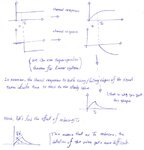iVenky
Advanced Member level 2
- Joined
- Jul 11, 2011
- Messages
- 584
- Helped
- 37
- Reputation
- 76
- Reaction score
- 35
- Trophy points
- 1,318
- Location
- College Station, Texas
- Activity points
- 6,124

I have attached a problem that is found in most of the channels- intersymbol interference. A square pulse is applied and the response is seen to be as shown in the figure. It is seen that the response reaches the peak value fast and then falls down to zero slowly. What's the main reason behind this? Don't tell me that it is because of the RC model. The peak value appears after Ts. This also results in the number of precursor taps to be lesser than the number of post cursor taps in the equalizer.
Thanks a lot
Last edited:



